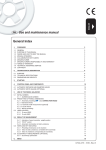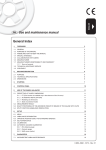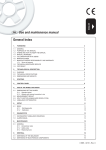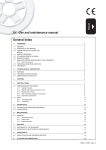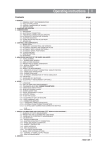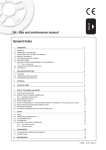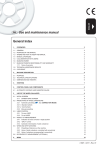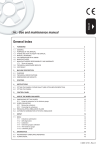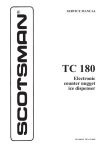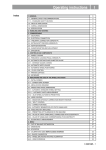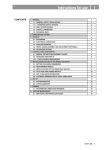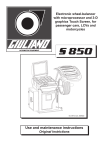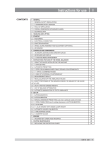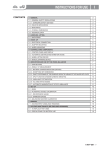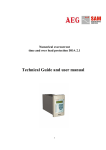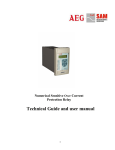Download cemb er85 touch video wheel balancer user manual
Transcript
ENGLISH GB Use and maintenance manual General Index 1. FOREWORD 3 1.1GENERAL 1.2 PURPOSE OF THE MANUAL 1.3 WHERE AND HOW TO KEEP THE MANUAL 1.4 MANUAL UPGRADES 1.5 COLLABORATION WITH USERS 1.6MANUFACTURER 1.7 MANUFACTURER'S RESPONSIBILITY AND WARRANTY 1.7.1 Terms of warranty 1.8 TECHNICAL ASSISTANCE SERVICE 1.9COPYRIGHT 3 3 3 3 3 4 4 4 4 5 5 2. MACHINE DESCRIPTION 6 2.1PURPOSE 2.2 TECHNICAL SPECIFICATIONS 2.3DIMENSIONS 6 6 6 3. STARTING 7 4. CONTROL PANEL AND COMPONENTS 10 4.1 AUTOMATIC DISTANCE AND DIAMETER GAUGE 4.2 SONAR DEVICE FOR AUTOMATIC WIDTH MEASUREMENT 4.3 TOUCH SCREEN 10 10 10 5 11 USE OF THE WHEEL BALANCER 5.1 INITIAL SCREEN 11 5.1.1 Screen-save screen 11 5.2 PRESETTING OF WHEEL DIMENSIONS 11 5.2.1 Automatic standard setting ( also Correction mode)11 5.2.2 ALUS wheel automatic presetting (Adhesive weights) 12 5.3 USER CONTROL 13 5.4 RESULT OF MEASUREMENT 13 5.5 WHEEL LOCKING 13 5.6 EXACT POSITIONING OF THE ADHESIVE WEIGHT BY MEANS OF THE GAUGE WITH CLIPS 14 5.7 “SPLIT” CONTROL (HIDDEN WEIGHT) 14 5.8 CORRECTION MODE 15 5.9 AUTOMATIC MINIMIZATION OF STATIC UNBALANCE 15 5.10 ECCENTRICITY MEASUREMENT 16 5.10.1 When and why matching 16 5.10.2 Presetting of tolerance on the machine17 5.10.3 Value of static unbalance, correlated with eccentricity 17 5.10.4 Value of unbalance corresponding to eccentricity 17 5.11 WHEEL ECCENTRICITY MEASUREMENTS 17 5.12 ECCENTRICITY OPTIMISATION 18 6.MENU 19 I 1011 - 07/12 - Rev. 01 6.1 MENU ACCESS DIAGRAM 19 6.2 UNBALANCE OPTIMIZATION 20 6.3 STATISTICS20 6.3.1 Weight statistics screen 20 6.4CALIBRATIONS 21 6.4.1 Gauge calibration 21 6.4.1.1 Distance gauge calibration 21 6.4.1.2 Diameter gauge calibration 21 6.4.1.3 Width gauge calibration 21 6.4.2 Balancing machine calibration 21 7. SETUP 7.1 7.2 7.3 7.4 7.5 22 LANGUAGE SCREEN-SAVER TIME ACOUSTIC SIGNAL SETTING THE CLOCK ECCENTRICITY SETUP 7.6 Options 7.6.1 Radial runout 7.6.2 Laser 7.6.3 Rim interior light 7.6.4 Wheel locking enable 7.6.5 Gauge locking enable 7.6.6 Tyre train 7.6.7 Weight statistics 7.6.8 User 7.6.9 Date 7.6.10 Time 7.6.11 Icon 7.6.12 LT automatic 7.6.13 Enabling of serial output RS232C (option) 7.7 BALANCING SETUP 7.7.1 Unit of unbalance measurement 7.7.2 Unbalance display pitch 7.7.3 Tolerance 7.8 CORRECTION METHOD 7.8.1 Standard correction method 7.8.2 External plane correction method 7.9 STATIC ALWAYS ENABLED 7.10 SPECIAL FUNCTIONS 7.10.1 Presetting the customer and user name 7.10.2 Wheel Balancing machine SELF TEST 22 22 22 22 22 22 22 22 22 22 22 22 23 23 23 23 23 23 24 24 24 24 24 24 24 24 24 24 24 24 8. DIAGNOSTICS 25 9. MAINTENANCE 27 9.1GENERAL 9.1.1 Introductory notes 9.1.2 Safety rules 9.1.3 Replacing fuses 9.1.4 Cleaning the TOUCH screen 27 27 27 27 27 10. DISPOSAL 28 10.1 DISPOSING OF THE BALANCER 10.2 DISPOSING OF ELECTRONICS COMPONENTS 28 28 11. SPARE PARTS 28 11.1 IDENTIFICATION AND ORDERING METHOD 28 12.ATTACHED DOCUMENTATION28 Use and maintenance manual Rev. 07-2012 ENGLISH 1. Foreword 1.2 PURPOSE OF THE MANUAL This manual, and the installation manual, contains the instructions required to use the machine safely and carry out routine maintenance work. This WARNING manual is an integral part of the INSTALLATION manual which should be consulted concerning starting and using the machine safely . Read carefully before continuing . 1.1GENERAL The machine has been constructed in conformity with the current EC Directives and the technical standards implementing the requirements, as stated in the declaration of conformity issued by the manufacturer and attached to the manual. This publication, hereinafter simply referred to as ‘manual’, contains all the information required to safely use and service the machine referred to in the Declaration of Conformity. This appliance, hereinafter is generically referred to as ‘machine’. The manual addresses operators instructed on the precautions to take in relation to the presence of electric current and moving devices. This publication is intended for all ‘users’ who as far as within their competence need to and/or are obliged to give instructions to others or operate on the machine themselves. These persons can be identified as follows: - operators directly involved in transporting, storing, installing, using and servicing the machine from when it is put on the market until when it is scrapped; - direct private users. The original Italian text of this publication constitutes the only reference to resolve any interpretation controversies related to the translation into the European Community languages. This publication forms an integral part of the machine and must therefore be kept for future reference until final dismantling and scrapping of the machine. Any calibrations, adjustments and extraordinary maintenance operations are not considered in this document as they may only be performed by the service engineer who must work on the machine according to the technical and rated characteristics for which it was built. Though it is fundamental to read this manual, it cannot replace skilled technical staff who must be adequately trained beforehand. The foreseen use and configurations of the machine are the only ones allowed by the manufacturer; do not attempt to use the machine in a different way. Any other use or configuration must be agreed in advance with the manufacturer in writing and in this case an annex will be attached to this manual. For use, the user must also comply with the specific workplace legislation in force in the country where the machine is installed. The manual also refers to laws, directives, etc., that the user must know and consult in order to accomplish the goals that the manual sets out to achieve. 1.3 WHERE AND HOW TO KEEP THE MANUAL This manual (and relative attachments) must be kept in a safe and dry place and must always be available for consultation. Make a copy and keep it in the archive. When exchanging information with the manufacturer or the technical assistance staff authorised by the former, quote the rating plate information and the serial number of the machine. This manual must be kept for the entire lifetime of the machine, and if necessary (e.g.: damage making all or some of it illegible, etc.) the user must request another copy exclusively from the manufacturer, quoting the publication code indicated on the cover. 1.4 MANUAL UPGRADES This manual is an integral part of the machine and reflects the state of the art at the moment it was put on the market. The publication complies with the directives in force on that date; the manual cannot be considered inadequate as a result of regulatory updates or modifications to the machine. Introduction 3 ENGLISH Use and maintenance manual Rev. 07-2012 Any manual upgrades that the manufacturer may see fit to send to users will become an integral part of the manual and must be kept together with it. 1.5 COLLABORATION WITH USERS - use in breach of specific regulations in force in the country of installation; - modifications made to the machine, software and operating logic, unless authorised by the manufacturer in writing; - unauthorised repairs; - exceptional events. The manufacturer will be pleased to provide its customers with any further information they may require and will consider proposals for improving this manual in order to more fully satisfy the requirements it was written for. In case of transfer of ownership of the machine, which must always be accompanied by the use and maintenance manual, the original user must inform the manufacturer of the name and address of the new user in order to allow it to send the new user any communications and/or updates deemed to be indispensable. Transfer of the machine to a third party must also include this manual; failure to include the manual automatically invalidates all the rights of the purchaser, including the terms of warranty, where applicable. If the machine is transferred to a third party in a country with a different language from the one written in this manual, the original user shall provide a faithful translation of this manual in the language of country in which the machine will operate. This publication is the property of the Manufacturer and may not be fully or partly reproduced without prior written agreement. The Manufacturer guarantees the machines it manufacturers against all manufacturing or assembly faults for 12 (twelve) months from the date of collection or delivery. 1.6MANUFACTURER The Manufacturer undertakes to replace or repair any part which it deems to be faulty free of charge at its factory, carriage paid. The machine identification data is indicated on the plate mounted on the machine. The plate below is shown for the sake of example. 1.7.1 Terms of warranty If a Manufacturer's repairman (or a person authorised by the same) is required to work at the user's facilities, the relative travel expenses and board and lodging shall be charged to the user. The free supply of parts under warranty is always subject to the faulty part being inspected by the manufacturer (or a person authorised by the same). The warranty is not extended following repairs or other work done to the machine. The warranty does not cover damage to the machine deriving from: 1.7 MANUFACTURER'S RESPONSIBILITY AND WARRANTY In order to make use of the manufacturer's warranty, the user must scrupulously observe the precautions contained in the manual, in particular he must: - never exceed the limits of use of the machine; - always constantly and carefully clean and service the machine; - have the machine used by people of proven capacity and attitude, adequately trained for the purpose. The manufacturer declines all direct and indirect liability caused by: - use of the machine in a different way from that indicated in this manual - use of the machine by people who have not read and fully understood the contents of this manual; 4 -transport; -neglect; - improper use and/or use not in compliance with the instructions in the operating manual - incorrect electrical connections. The warranty is invalidated in case of: - repairs made by people who were not authorised by the manufacturer; - modifications that were not authorised by the manufacturer; - use of parts and/or equipment that were not supplied or approved by the manufacturer; - removal or alteration of the machine identification plate. Introduction Use and maintenance manual Rev. 07-2012 TECHNICAL ASSISTANCE SERVICE ENGLISH 1.8 For any technical service operation, contact the manufacturer directly or an authorised dealer always quoting the model, the version and the serial number of the machine. 1.9COPYRIGHT The information contained in this manual may not be disclosed to third parties. Partial or total duplication, unless authorised by the Manufacturer in writing, through photocopying, duplication or other systems, including electronic acquisition, is breach of copyright and can lead to prosecution. Introduction 5 2. Machine description 2.1PURPOSE It is used to balance the wheels of cars, vans, 4-WD, motorcycles and scooters. The wheels must weigh less than 75 kg. and, when fitted on the balancing machine, must not interfere with any fixed part of the machine, excluding the shaft and support adaptor. The machine is supplied with equipment enabling the vast majority of car wheels available on the market to be fitted. Other wheels with special dimensions, geometry and centring require special adaptors supplied on request. The machine can operate only on flat non resilient floor. To lift the machine, lever only on the base where the 3 support points are located. never, under any circustance, apply force to other points such as the spindle, head, or accessory shelf. It functions properly without having to fasten it to the floor with wheels weighing up to 35 kg; for heavier wheels, fasten it at the points indicated. Do not mount anything other than motorbike, car or truck tyres on the wheel balancer. 1 4 5 2 Thanks to the new and exclusive VDD (Virtual Direct Drive) system, reliable unbalance measurements can be made in a short time, almost half the time of the cycle used with respect to other balancers in this range. The main features include: ▪▪ machine settings menu. ▪▪ touch panel ▪▪ adhesive weight positioning laser ▪▪ rim interior light ▪▪ wheel locking ▪▪ automatic width ▪▪ radial eccentricity measurement ▪▪ static programme, ALUS; SPLIT; unbalance optimization; exact correction weights with gauge lock in position; self diagnostics; calibration. ▪▪ automatic minimisation of static unbalance 2.2 TECHNICAL SPECIFICATIONS The following data refers to the balancer in its standard configuration. Single-phase power supply 115 / 230 V 50/60 Hz Protection class IP 54 Max.power consumption 0,15 Kw Balancing speed 100 min-1 Cycle time for wheel 4.7 sec. (5 3/4”x14”) 15 Kg. Measurement uncertainty 0,5 g Average noise < 70 dB (A) Rim width setting range 1.5” ÷ 20” or 40 ÷ 510 mm Diameter setting range 10” ÷ 30” or 265 ÷ 765 mm Min/max. compressed air pressure 8 ÷ 10 kg/cm2 approx. 0.8 to 1 Mpa; approx. 8 to 10 bar; 6 1. 2. 3. 4. 5. 6. 7. TOUCH CONTROL PANEL WEIGHT-TOOL HOLDER AUTOMATIC GAUGE COLLAR BP PEDAL WHEEL POSITIONING LASER WHEEL INTERIOR LED LIGHT < 75 Kg. Machine weight 120 Kg. 2.3DIMENSIONS 1480 7 approx. 115 to 145 psi. Maximum wheel weight 1750 3 1320 ENGLISH Use and maintenance manual Rev. 07-2012 1230 6 1270 Machine description Use and maintenance manual Rev. 07-2012 ENGLISH 3. Starting 7. Position the wheel on the terminal with the inner part facing the balancer; Before WARNING switching on the machine , make sure that all the connections described in the The INSTALLATION have been made correctly . chapter following operations involve a potential risk for the operator , given the presence of voltage on the equipment . The Personal Protective Equipment described INSTALLATION manual must be worn and work must be done with due care and attention . Operations may only be performed by a specialised technician . in the Before powering the machine, carry out the following checks: 1. check that the balancing machine touches the floor at the three support points; 2. make sure that all the parts of the balancer are cor rectly connected and fixed; 3. make sure that the parameters (voltage and frequency) of the mains power supply are compatible with those indicated on the rating plate of the balancer; 4. make sure the power cable is correctly connected; 5. make sure the machine shaft and flange hole are clean. Any CAUTION traces of dirt may affect balancing accuracy . 6. to turn on the wheel balancer press the switch on the rear of the machine without touching the ma- chine head 8. 9. Firmly attach the wheel to the balancer shaft. Use the specific collar provided. For operation of the spindle with pneumatic locking (constant thrust air spring) connect the wheel balancer to the com pressed air mains. The connection fitting is located at the back of the machine. At least 8 Kg/cm2 (~ 0.8 MPa; ~ 8 BAR; ~ 115 PSI) pressure is needed for correct operation of the release device. The pedal allows fastening/releasing the whe- el on the adapter using the collar. Press downwards to enable/disable the lock. 10.At this point, you can read the tyre measurements and perform balancing. 11.Lower the splash guard, when fitted, and press the START button to perform the spin. 12.The wheel is automatically locked when reaching the correct angular position for weight application on the inside and outside, turning it slowly by hand. To unlock the wheel, turn it hard to move it from the correct correction position. If the unbalance is within tolerance, the wheel is locked automatically. It Starting WARNING is prohibited to touch any part of the machine during the balancing cycle . 7 SE2-MOUNTING A B C D E F G SE2 MOUNTING SE2-DISMOUNTING 36 0° A B C D Cone E IT Quando possibile, centrare le ruote con cono dall'interno (vedi disegno). Evitare di usare il manicotto RL con cerchi di ferro. GB Whenever possible, centre the wheels with the cone from the inside (see the drawing ). Avoid using the RL sleeve with metal rims. FR Lorsque c’est possible, centrer les roues avec le cône de l’intérieur (voir dessin). Eviter d’utiliser le manchon RL avec les jantes en fer. DE Wenn möglich, die Räder mit Konus von Innen heraus zentrieren (siehe Zeichnung). Bei Eisenfelgen die Verwendung der Muffe RL vermeiden. ES Siempre que sea posible, centrar las ruedas con cono desde dentro (véase dibujo). Evitar usar el manguito RL con llantas de hierro. PT Quando possível, centre as rodas com cone pelo lado de dentro (ver � gura). Evite utilizar a luva RL com jantes de ferro. SE2 DISMOUNTING ENGLISH Use and maintenance manual Rev. 07-2012 4. Control panel and components 4.1 AUTOMATIC DISTANCE AND DIAMETER GAUGE This gauge allows measurement of the distance of the wheel from the machine and the wheel diameter at the point of application of the counterweight. It also allows correct positioning of the counterweights on the inside rim by using the specific function ( INDICATION OF EXACT CORRECTION WEIGHT POSITION ) which allows reading, on the monitor, the position used for the measurement within the rim (for calibration, see the corresponding section). 4.2 SONAR DEVICE FOR AUTOMATIC WIDTH MEASUREMENT Width gauging is through a SONAR device which measures the distance of the wheel without mechanical contact, merely by closing the guard and each time a valid measurement has been made with gauge AUTOMATIC DISTANCE AND DIAMETER GAUGE. 4.3 TOUCH screen The function keys are selected by pressing on the touch screen. Press Never 10 CAUTION the buttons with your fingers . use the counterweight grippers or other pointed objects ! Control panel Use and maintenance manual Rev. 07-2012 The monitor shows several information and suggests various alternative ways of use to the operator. This is through various “screens”. 5.1 5.1.1 SCREEN-SAVE SCREEN Name of the wheel balancer’s owner. Can be preset via the monitor. INITIAL SCREEN 5.2 PRESETTING OF WHEEL DIMENSIONS 5.2.1 Automatic standard setting ( also CORRECTION MODE) Buttons enabled: ENGLISH 5 Use of the wheel balancer main functions screen ( MENU ACCESS DIA- GRAM) selecting static correction wheel lock/unlock eccentricity screen selection Close the guard to perform a balancing spin. Dimensions gauge: when extracted, the Dimensions screen is selected ( AUTOMATIC STANDARD SETTING). If the machine remains on the initial screen for a certain amount of time without being used, the system is automatically switched to a screen-save. Striking of any key, movement of the wheel of distance + diameter gauge will cause automatic switching from the screen-save menu to the initial screen. FUNCTION ON INDICATOR: Sonar “WIDTH”. L.T. /SUV FUNCTION ON INDICATOR (see enabled buttons) CAUTION when the screensaver is active, automatic starting activated by the guard is not available for safety reasons . Use of the wheel balancer 11 ENGLISH Use and maintenance manual Rev. 07-2012 a) Standard weight Using the special grip, move the end of the gauge against the rim in one of the positions A/B shown. Pos A 5.2.1.1 Automatic width measurement Slowly lower the guard after making the automatic measurement of the distance + diameter to automatically measure the wheel width. If the width measured is incorrect (out of range), the following message appears: “Sonar measure is out of range:” = repeat” = manual set-up” Press to re-lower the guard and repeat the width Pos B measurement. Press b) Adhesive weight: in the position indicated below. Position of adhesive weights FI to go to the dimensions panel for manual insertion of the width measurement. Manually presetting is possible by using the push buttons as described in “PRESETTING OF WHEEL DIMENSIONS”. 5.2.2 ALUS wheel automatic presetting (adhesive weights) Make two consecutive measurements inside the rim on two correction planes of your choice as indicated in figure. When the acoustic signal is enabled ( ACOUSTIC SIGNAL), the acquisition is accompanied by a “beep”. INDICATION FI FE always use the round part of the striker plate Hold the gauge in position for at least 2 seconds. If the acoustic signal is enabled ( ACOUSTIC SIGNAL), the acquisition of the dimensions is accompanied by a “beep”. Set the distance+diameter gauge to the rest position. Position of adhesive weights The other enabled buttons are: The enabled buttons are: This button is used to improve the dimensional calibration of large-diameter wheels such as off- road, trucks, wheels which protrude significantly from the rim. Press this button several times to select the type of tyre projection (from 1.0” to 2.0”). The option is disengaged at the end of current Width Measurement. user call/save control selecting the manual dimension presetting screen return to initial screen. selecting the manual dimension presetting screen select the type of weight to apply ( CORRECTION METHODS). Close the guard to perform a balancing spin. return to initial frame Close the guard to perform a balancing spin. 12 Use of the wheel balancer Use and maintenance manual Rev. 07-2012 USER CONTROL the residual value to a precision of 0.5 g (0.1 oz.). Allows storing the dimensions of three types of wheels. In this way three users can work on three different vehicles at the same time using the same wheel balancer. The system keeps three programs in memory, each with different dimensions set. 1. Press one of the three buttons to select the user (1, 2, 3). 2. Enter the dimensions. 3. Lower the guard to balance the wheels as normal and automatically store the program for the user currently selected. When selecting the user , the relative pro- The following buttons are enabled: display of residual out-of- balance. selection of correction mode (STATIC/DUAL SURFACE). When the mode is changed, the unbalance values are recalculated automati cally on the basis of the previous spin. Simultaneous display of the dynamic+static unbalance can be enabled through the special function in Setup (see par. STATIC ALWAYS ENABLED). eccentricity measurement graph N.B : 1. The symbol above the key is displayed in yellow if the first harmonic eccentricity exceeds the limit set in the setup parameters (FIRST HARMONIC LIMIT). 2. When this push button is held down for more than 1.5 seconds, eccentricity measurement is temporarily disenabled (enabled in SETUP). To re-enable eccentricity measurement, press push button [4] again for more than 1.5 seconds. Every time the machine is switched on, the status of eccentricity measurement reflects the settings in SETUP. gram (1, 2 or 3) is called for subsequent wheel balancing operations without having to enter the dimensions again. INDICATION Remember to set correctly the dimensions in the manner already decribed in the paragraph “PRESETTING OF WHEEL DIMENSIONS”. 5.4 RESULT OF MEASUREMENT Inside unbalance Static unbalance indicator indicator Outside unbalance indicator unbalance split function enable enable indication of the longitudinal position of the out-of-balance ( INDICATION OF EXACT CORRECTION WEIGHT POSITION) wheel lock/unlock selection of special functions Close the guard to perform a balancing spin. INDICATION If the machine remains on this screen without being used for more than the time preset in the Setup parameters, the screen automatically returns to the screen-save. Lower the guard to make a measurement spin. Close the guard to perform a measurement spin. If laser option = OFF : after positioning and locking the wheel, apply the weight vertically at the top. If laser option = ON : apply the clip-on weights at 12 o’clock. If using adhesive weights, when the correction position is reached, the laser turns on indicating the point where to apply the adhesive counterweight. When the beep signal is enabled ( ACOUSTIC SIGNAL), reaching of the correction position is accompanied by a “beep”. If the out-of-balance is less than the chosen threshold value, “0K” appears instead of the out-of-balance value to indicate, 5.5 WHEEL LOCKING The wheel is automatically locked when reaching the correct angular position for weight application on the inside and outside, turning it slowly by hand. To unlock the wheel, turn it hard to move it from the correct correction position. If the unbalance is within tolerance, the wheel is not automatically locked. By pressing the button it is possible to lock/release the spindle in any position to facilitate the wheel assembly. on that particular side, that the wheel is in tolerance; press on the unbalance indicators to display Use of the wheel balancer 13 ENGLISH 5.3 ENGLISH Use and maintenance manual Rev. 07-2012 5.6 EXACT POSITIONING OF THE ADHESIVE WEIGHT BY MEANS OF THE GAUGE WITH CLIPS The position repeater screen can be accessed in 2 different ways: ▪▪ Pull out the gauge after placing the wheel in the correc tion position on one of the two sides ▪▪ Press the button at any time Always pull out the gauge to position A as shown in figure page 12 ▪▪ A mobile coloured arrow [ ] indicates the approach of the weight towards the correction position. ▪▪ When a fixed arrow [ ] is reached, rotate the wheel to correction position (FI or FE) and apply the counterweight by rotating the gauge tip towards the outside, into the position where the pincer touches the wheel (where appropriate use the weight pusher). ▪▪ The correction weight application position is automati cally reset in relation to the position of the distance + diameter gauge (pos. A). INDICATION When the acoustic signal is enabled ( If laser option = OFF To split the unbalance detected in two different positions, proceed as follows : 1. Position static unbalance or ALUS external side in the correction position : 2. Select a spoke close to the 12 o’clock postion to be cor rected, more it into the 12 o’clock position and press button 3.Turn the wheel in the rotation direction indicated on the unbalance display, brining the second spoke to the 12 ACOUSTIC when a fixed arrow [ ] is reached, the gauge is automatically locked to prevent shifts during application of the correction weight. To release and bring the gauge back to the rest position, lower it to below 10” diameter. FE “SPLIT” CONTROL (HIDDEN WEIGHT) SPLIT is only possible in the event of static unbalance or ALUS external side and is used to hide any adhesive weights correcting unbalance behind the rim spokes. o’clock position and press button ] is SIGNAL), attainment of the fixed arrow status [ accompanied by a “beep”. If gauge locking is enabled ( GAUGE LOCKING), FI 5.7 Turn the wheel in direction of rotation. Turn the wheel in reverse direction of rotation. 4. At this point, two indications appear on screen for positioning of the unbalance correction spokes. 5. Position the spokes indicated on screen in the 12 o’clock position and correct with the value displayed. If laser option = ON To split the unbalance measured in two different positions, operate as follows: 1. Position the static unbalance or outside ALUS in the 14 in the correction position: Use of the wheel balancer 5.9 2. Press AUTOMATIC MINIMIZATION OF STATIC UNBALANCE and hold down until the laser points to the spoke where you want to correct Initial unbalance 3. Release the sx button dx g 4. Turn the wheel in the unbalance rotation direction indicated on the display until the second spoke is in the position indicated by the laser and press the Possible approximations sx button At this point, two indications appear on screen for positioning of the unbalance correction spokes Move the spokes indicated to the correction position and correct the value displayed Any error in this procedure is clearly shown on screen. Always follow the information provided by the wheel to optimise correction. 5.8 CORRECTION MODE After having performed automatic measurement of the inner side, it is possible to place the correction weights as required by pressing push buttons sx dx g static residue 5. 6. g Phase shift 50° g 4g With traditional wheel balancer sx dx g static residue 3 g g sx dx g static residue1 g g dx g static residue g 6g Choice with minimum static unbalance This program is designed to improve the quality of balancing without any mental effort or loss of time by the operator. In fact by using the normal commercially available weights, with pitch of 5 in every 5 g, and by applying the two counterweights which a conventional wheel balancer rounds to the nearest value, there could be a residual static unbalance of up to 4 g. The damage of such approximation is emphasized by the fact that static unbalance is cause of most of disturbances on the vehicle. This new function, resident in the machine, automatically indicates the optimum entity of the weights to be applied by approximating them in an “intelligent” way according to their position in order to minimize residual static unbalance. INDICATION In the event of automatic measurement of both sides, if the difference between the inner and outer diameters is greater than or equal to 2”, the system sets the inner side spring weight. To modify this presetting, press the button. To display static unbalance, press the button on the measurement screen (for ALUS static, the inner side diameter is always considered). Use of the wheel balancer 15 ENGLISH Use and maintenance manual Rev. 07-2012 ENGLISH Use and maintenance manual Rev. 07-2012 5.10 ECCENTRICITY MEASUREMENT 5.10.1When and why matching Example 2 The software associated with eccentricity measurement is a powerful tool for determining the need to perform relative rotation between the rim and tyre in order to reduce the eccentricity of the wheel down to acceptable limits. The principle adopted is based on the consideration that a rim with acceptable tolerance, mounted with an acceptable tyre, can statistically generate a total eccentricity which is not acceptable but can be improved by matching. Generally speaking, rim measurement is not necessary, accurate or useful because: ▪▪ To measure the rim it is necessary to remove the tyre. There can by coarse errors on the outside (e.g. aluminium wheels!) ▪▪ The two rim sides can be eccentric in a very different way. Therefore to which one to make reference? What is the effect on the tyre mounted? ▪▪ To improve the eccentricity of a wheel, the rim should be eccentric, to compensate the tyre. And viceversa. ▪▪ If after a rotation by 180° of a wheel, the value is still out-of-tolerance, either the tyre or rim are too eccentric: One of the two must be replaced! wheel Ideal wheel rim tyre rotation axle Rim + 0.8 mm Tyre - 0.6 mm Wheel + 0.3 mm Eccentricity of the single items has been compensated. The wheel is acceptable. Example 1 Example 3 wheel wheel Ideal wheel rim Ideal wheel rim tyre tyre rotation axle rotation axle Rim + 0.8 mm Tyre + 0.6 mm Rim 0 mm Tyre + 1.2 mm / 0,045” Wheel + 1.3 mm Wheel + 1,2 mm / 0,045” Eccentricity of the wheel is excessive, due to an acceptable rim or tyre but randomly placed in an “unfortunate” relative position. Eccentricity of the wheel cannot be compensated by the rotation because the rim is perfect! SOLUTION: Rotate the tyre on the rim by 180° RESULT: wheel eccentricity 0.3 - 0.4 mm (in tolerance) 16 SOLUTION: Rotate the tyre on the rim by 180° RESULT: no improvement is obtained. Use of the wheel balancer 5.10.2 Presetting of tolerance on the machine There is no general rule concerning acceptability of an eccentricity value . As a first approximation we consider it correct to use a threshold of 1 to 1.5 mm. The E/ECE/324 standard prescribes 1.5 mm as max. eccentricity of a rebuilt tyre. 5.10.3 Value of static unbalance, correlated with eccentricity The maximum limit of the first harmonic can be set ( FIRST HARMONIC LIMIT ). When this limit is exceeded, the wheel balancer displays the red symbol above the button to indicate an eccentricity condition that needs to be corrected. Press on the unbalance measurement screen to display the eccentricity measurement graph.: Clear indication is given in the Measurement screen of both the value and position of the static unbalance as well as the eccentricity. In fact, it is interesting to check the correlations of the two values, above all of the two positions. When the two positions have a similar angle (± 30° one from the other), there is a clear sign that an eccentricity is present which can be compensated by matching. 5.10.4 Value of unbalance corresponding to eccentricity For user’s reference, the centrifugal force is calculated corresponding to a certain speed, compared to the force generated by the eccentricity present on the tyre (calculated with an approximate average elastic constant). 5.11 WHEEL ECCENTRICITY MEASUREMENTS The external radial eccentricity measurement is taken automatically at the end of the unbalance measurement without having to perform specific procedures; remember to position the sonar sensors in front of the surface to be measured before performing a spin. GRAPH 1 (yellow): shows the real peak-to-peak eccentricity. GRAPH 2 (red): shows the first harmonic eccentricity. An almost straight line graph indicates a wheel in perfect condition. When the wheel is moved the cursor on the graph indicates the current value with the phase referred to the measurement sensor. The much enlarged figures show the outer tyre surface and axis of wheel rotation. A B The following buttons are enabled: to start an eccentricity optimization (ECCENTRI- CITY OPTIMIZATION) to return to the unbalance measurement frame. Fig. A - shows measurement of the total Peak-to-Peak eccentricity defined as maximum radial deviation of the tyre surface. Fig. B - shows measurement of the eccentricity of the 1st harmonic, i.e. the eccentricity of that circle which “recopies” the tyre shape, by averaging the local deviations of the tyre from the round shape. Obviously the P.P. measurement is normally greater than that of the 1st harmonic. Tyre manufacturers normally supply two different tolerances for the two eccentricities. Use of the wheel balancer 17 ENGLISH Use and maintenance manual Rev. 07-2012 ENGLISH Use and maintenance manual Rev. 07-2012 If the value of the first harmonic is greater than the maximum limit, at the end of the eccentricity measurement, the following window appears: to start an eccentricity optimization (ECCENTRI- CITY OPTIMIZATION) return to the initial screen. 5.12 ECCENTRICITY OPTIMISATION This procedure is used to assess the possibility of rotating the tyre on the rim to reduce the eccentricity of the wheel to a minimum. The eccentricity optimisation procedure is normally recommended for first harmonic values greater than the maximum limit ( FIRST HARMONIC LIMIT). Follow the simple instructions shown on the monitor. The following is displayed at the end of the procedure: Mark the rim and tyre in the positions indicated on the monitor and rotate the tyre on the rim until the positions are aligned. return to the initial screen. 18 Use of the wheel balancer Use and maintenance manual Rev. 07-2012 ENGLISH 6.Menu 6.1 MENU ACCESS DIAGRAM PASSWORD : press in sequence the following buttons: 1 2 3 4 Menu 19 Use and maintenance manual Rev. 07-2012 UNBALANCE OPTIMIZATION For the TOTAL counters a correct password must be entered. ENGLISH 6.2 3 to access the weight statistics screen to return to the previous screen to return to the measurement screen. 6.3.1 Weight statistics screen The program allows total wheel out-of-balance to be reduced by compensating, when possible, tyre and rim out-of-balance values. It requires two runs, rotating the tyre on the rim on the second run. Having performed a run, press + 1 and follow the on-screen instructions. 6.3 STATISTICS 1 Each horizontal line indicates the number of clip-on and adhesive weights used to balance the wheels in the period between the two dates indicated on the screen (in square brackets). Tot g (Tot oz): indicates the total weight value (clip-on and adhesive weights) used to balance the wheels in the interval indicated on the screen Tot n: indicates the total number of clip-on and adhesive weights used to balance the wheels in the interval indicated on the screen 2 3 The following buttons are enabled: DAILY N° OF RUNS: Indicates the number of runs performed as from switching on the machine. Such parameter is automatically reset after switching the machine off. TOTAL N° OF RUNS: Indicates the number of runs starting from the date indicated in square brackets. This parameter remains memorized even when the machine is switched off. The following buttons are enabled: press to reset the relative 1 2 counter. 20 press and enter the password to reset the weight statistics screen to return to the previous screen to return to the measurement screen INDICATION To enable saving of the weight statistics ( WEIGHT STATISTICS) The weights are saved only if the unbalance display pitch is set to 5 in 5. Menu Use and maintenance manual Rev. 07-2012 When CALIBRATIONS 4 6.4.2 Balancing machine calibration is pressed from the Special Functions menu, access is gained to the Calibration menu. 6.4.1 Gauge calibration 6.4.1.1 Distance gauge calibration To calibrate the distance gauge, set it in rest position and then on the adapter plane. When done, set the gauge in rest position. If calibration is correct, the wheel balancer is ready for operation, otherwise an error message may be displayed if there are errors or malfunctioning; in this case repeat calibration. to cancel the distance gauge calibration function if has erroneously been accessed. To calibrate the balancing machine, use a wheel with steel rim of average dimensions, e.g. 6” x 14” (±1”). To properly perform the procedure: ▪▪ Mount a wheel on the machine, even unbalanced, and very carefully set its dimensions. INDICATION etting incorrect measurements will result in the machine S not being correctly calibrated, and balancing of subsequent wheels will hence be incorrect until the machine is recalibrated with the correct measurements!! ▪▪ Follow the on-screen instructions. 6.4.1.2 Diameter gauge calibration Position the gauge rod of the spindle sleeve as indicated in the figure and press . Rotate the gauge downwards and place the gauge rod in contact with the spindle sleeve as indicated in the figure and press . to cancel the diameter gauge calibration function if it has erroneously been accessed. 6.4.1.3 Width gauge calibration When calibrating the width gauge, set a measurable dimension as follows: A - GAUGE “ZERO” DISTANCE SONAR “ZERO DISTANCE DISTANZA 0 (Zero calibro) to set the distance in mm between the SONAR sensor and the distance gauge clip in pos. 0. to confirm. to cancel the width gauge calibration function if it has erroneously been accessed. Menu 21 ENGLISH 6.4 ENGLISH Use and maintenance manual Rev. 07-2012 7. Setup The Setup screen provides the user with many possibilities required for presetting the machine according to his own requirements. Such settings remain unaltered even when the machine is switched off. Matching At the end of the spin, enables/ disables display of the window that recommends optimising the eccentricity for values greater than the first harmonic limit set. The following buttons are enabled: return to previous window 7.6 OPTIONS 7.6.1 Radial runout return to Measurement screen Enables/disables radial eccentricity measurement. 7.6.2 Laser 1 - 7.1 for selection of the parameter. 7 LANGUAGE This function allows selecting the language to be used for displaying descriptive and diagnostic messages regarding machine operation. 7.2 SCREEN-SAVER TIME If this function is enabled, the screensaver will automatically be activated when the machine is not used for a certain period of time. This function can be disabled by setting it to 0. 7.3 7.6.3 Rim interior light Enables/disables the rim interior light. 7.6.4 Wheel locking enable Enables/disables wheel locking in the correction position ( WHEEL LOCKING). The possible options are: OFF: disabled ON: enabled ACOUSTIC SIGNAL When “ON” is selected, the sending of an acoustic signal (beep) is enabled in the following cases: ▪▪ when any push button is pressed; ▪▪ when dimensions are acquired in automatic mode; ▪▪ when the correct angular position for weight application is reached in the Measurement screen; ▪▪ when the correct angular position for weight application is reached in the Position Repeater screen. 7.4 If enabled, the weight application position is indicated in correspondence to the laser (5 o’clock) to facilitate rim cleaning and adhesive weight application. SETTING THE CLOCK 7.6.5 Gauge locking enable Enables/disables distance gauge locking when the correct distance has been reached to apply the adhesive weight to correct the unbalance. To release the gauge, lower it to below 10” diameter. 7.6.6 Tyre train Used to set date and time correctly. Follow the instructions on the screen. 7.5 ECCENTRICITY SETUP Enables display of a menu where the following parameters can be set: Eccentricity unit of measure It is possible to select display of eccentricity measurements in mm or inches. First harmonic limit The first harmonic limit beyond which it is felt suitable to rotate the tyre on the 180° rim. Recommended Limit = 1.2 mm. 22 Setup Use and maintenance manual Rev. 07-2012 8. To obtain an overview of the wheel balancing values, press the ENGLISH This function allows balancing the four wheels of a vehicle, plus the spare wheel if necessary, and obtaining the information on how to fit these wheels on the vehicle in such a way that the vibrations due to residual eccentricity of each wheel is reduced to a minimum. The ‘TYRE TRAIN’ function can be enabled and disabled from the MENU ( MENU ACCESS DIAGRAM ). For best use of this function proceed as follows: symbol. A window appears: AUTOMATIC TYRE SET 1. Prepare numbered stickers to identify the wheels. 2. Press the button to start the procedure. 3. Mount the first wheel and correctly position the radial and lateral eccentricity measurement sonars. 4. Balance the wheel and identify it with number 1. 5. Repeat steps 3 and 4 for the remaining three wheels, plus the spare wheel if necessary, each time identifying the wheel with a progressive number from 2 to 5. 6. Each time the spindle is opened, the wheel balancer highlights the best fitting solution for the wheels balan ced up to that moment. The centre of the screen shows an outline of the vehicle with the four tyres plus the spare; each time you spin a wheel, the number of the wheel to be fitted in each position on the vehicle is indicated (front/rear axles and right/left). 7. The procedure can be reset at any time by pressing the button . If the spindle is opened incorrectly, the balancing sequence is interrupted and, consequently, the end result will be incorrect. MANUAL TYRE SET 1. Gather together adhesive symbols to identify the wheels. 2. Press and to start the procedure. 3. Fit the first wheel and place the radial eccentricity measurement sonar in the correct position. 4. Balance the wheel, identify it using the number 1 5. 6. 7. and press . Repeat points 3 and 4 for the other three wheels and identify the wheels using the numbers 2, 3 and 4. Each time data is saved, the balancing machine highlights the best fitting solution for the wheels balanced up to that moment. The middle part of the screen shows a stylised vehicle with four tyres; at each spin the number of the wheel to be fitted in each position (rear/front axle left/right) is indicated on each of the tyres. The procedure can be rest at any time by pressing and Setup The following buttons are enabled: to return to the measurement screen resets the tyre set saves the tyre (only if Tyre Set = manual) 7.6.7 Weight statistics If enabled, it allows saving the weights used to balance the wheels ( WEIGHT STATISTICS SCREEN ); this function can be disabled by setting it to “OFF”. 7.6.8 User Enables/disables user selection display. 7.6.9 Date Enables/disables date display. 7.6.10 Time Enables/disables time display. 7.6.11 Icon Enables/disables status icon display. 7.6.12LT automatic If set to ON, the wheel bulges are automatically calculated; the calculated value can however be modified by pressing the button . . 23 ENGLISH Use and maintenance manual Rev. 07-2012 7.6.13E nabling of serial output RS232C (option) This option enables/disables the sending of the measured unbalance and phase values to serial output RS232C. Transmission speed 9600 baud Data format 1 bit Start 8 bit Data None parity 1 bit Stop At the end of each unbalancing measuring spin, the balancing machine transmits the data regarding the measured unbalance. The items of data transmitted via serial line are in ASCII format and are separated between each other by the <cr> character (0x0d). Sending sequence is as follows: - 00000 <cr> - Value of correction weight, left side <cr> - Correction phase, left side <cr> - Value of correction weight, right side <cr> - Correction phase, right side <cr> The first 5 zero bytes represents the start of transmission message. The correction values are expressed in grams, in steps of .1 gram. The phase values are expressed in degrees, in the range 0 ÷ 359. 7.7 BALANCING SETUP 7.7.1 Unit of unbalance measurement It is possible to select whether to display the unbalance values expressed in grams or ounces. 7.8.2 External plane correction method If correcting with adhesive weights, the unbalance is considered within tolerance when the recalculated external plane weight (clip-on weights) is lower than the tolerance set. Additional windows appear on the screen always displaying the residual external plane value (clip-on weight): 7.9 STATIC ALWAYS ENABLED Simultaneous display of the selected correction plane unbalance as well as STATIC unbalance can be enabled/disabled. The static screen can be selected at any time by pressing on the measurement screen and selecting the static weight. 7.7.2 Unbalance display pitch This represents the display pitch of the unbalance and varies according to the unit of measurement selected. The selection “5 g” (1/4 oz) enables display of the correction values on both sides such as to bring the static unbalance to 0 (theoretical). It is recommended to preset this function as standard use of the machine as it improves the balancing quality. The computer makes a complex calculation which allows cancelling the residual static unbalance by varying the value and position of the counterweights fixed in steps of 5 grams (1/4 oz). 7.10 SPECIAL FUNCTIONS 7.7.3 Tolerance An automatic self-diagnostic cycle is provided for easier trouble-shooting ( Consult the extraordinary maintenance manual or contact Technical Service). This is the unbalance threshold below which the word “OK” instead of the unbalance value appears on the screen at the end of the spin. 7.8 7.10.1 Presetting the customer and user name The machine can be customized by presetting: a) The name appearing on the Initial screen (screen-save). 7.10.2 Wheel Balancing machine SELF TEST CORRECTION METHOD One of the two possible correction methods can be selected based on the specific requirements of the customer. 7.8.1 Standard correction method The wheel balancer considers the unbalance within tolerance when the value of each single plane is lower than the tolerance set. 24 Setup Use and maintenance manual Rev. 07-2012 The ENGLISH 8. Diagnostics WARNING information in the ised people who must POSSIBLE REMEDY column requires work to be performed by specialist technicians or other authoralways work using the P ersonal P rotective E quipment indicated in the INSTALLATION manual . I n some cases , this work can be performed by a normal operator . ERROR CAUSE POSSIBLE REMEDY Black The wheel balancer does not switch on. 1. 2. 3. 4. Verify correct connection to the mains. Verify and eventually replace the fuses on the power card. Verify monitor function. Replace the computer board. Err. 1 No rotation signal. 1. 2. 3. Check in self-diagnostics that the encoder functions properly. Replace the phase pick-up board. Replace the computer board. Err. 2 Speed too low during detection. During the unbalance measurement revolutions, the wheel speed has fallen to below 42 rpm. 1. 2. 3. 4. Make sure that a vehicle wheel is mounted on the wheel balancer. Use the self-diagnostics function to check the encoder. Disconnect the piezo connectors from the board and do a spin (if no error is detected, replace the piezo sensors). Replace the CPU board. Err. 3 Unbalance too high. 1. 2. 3. 4. 5. Verify wheel dimension settings. Check detection unit connections. Perform machine calibration. Mount a wheel with more or less known unbalance (less than 100 grammes) and verify the response of the machine. Replace the computer board. Err. 4 Rotation in opposite direction. After pressing [START], the wheel starts turning in the opposite direction (anticlockwise). 1. 2. Check in self-diagnostics that the encoder functions properly Check the bearing/spring of the phase generator Err. 5 Guard open The [START] pushbutton was pressed without first closing the guard. 1. 2. 3. 4. Reset the error by pressing pushbutton [7]=End. Close the guard. Verify the function of the protection uSwitch. Press the [START] pushbutton. Err. 6 Spindle open. The [START] button has been pressed without first having closed the spindle 1. 2. 3. Reset the error by pressing the button [7]=End Close the spindle Press the [START] button Err. 7/ Err. 8/ Err. 10 NOVRAM parameter read error 1. 2. 3. 4. 5. Repeat machine calibration Shut down the machine. Wait for a minimum time of ~ 1 Min. Re-start the machine and verify correct operation. Replace the computer board. Err. 9 NOVRAM parameter write error. Replace the computer board. Err. 11 Speed too high error. During unbalance measurement rotation, wheel speed is more than 270 rpm. 1. 2. 3. Check if there is any damage or dirt on the timing disc. Check in self-diagnostics that the encoder functions properly. Replace the computer board. Err.14/ Err.15/ Err.16/ Err.17/ Err.18/ Err.19 Unbalance measurement error. 1. 2. 3. 4. Check in self-diagnostics that the encoder functions properly Check detection unit connections. Verify machine earth/ground connection. Mount a wheel with more or less known unbalance (less than 100 grammes) and verify the response of the machine. Replace the computer board. Diagnostics 5. 25 ENGLISH Use and maintenance manual Rev. 07-2012 Err. 22 Maximum number of spins possible for the unbalance measurement has been exceeded. 1. Check that a vehicle wheel has been mounted on the wheel balancer. 2. Check in self-diagnostics that the encoder functions properly 3. Replace the computer board. Err. 24 Distance between the spokes less than 18 degrees. 1. 2. Err. 25 Distance between the spokes greater than 120 degrees. 1. The maximum distance between the spokes where the unbalance is to be split must be less than 120 degrees. 2. Repeat the split function increasing the distance between the spokes. Err. 26 First spoke too far from the unbalance 1. 2. Err. 30 Clock error Replace the computer board. Err.40/ Err.41/ Err.42/ Err.43 Eccentricity graph plotting procedure error. Perform a new eccentricity measurement. Err.45/ Err.46/ Err.47/ Err.48 Eccentricity graph value display readout error. Perform a new eccentricity measurement. Err.50/ Err.51/ Err.52/ Err.53 Eccentricity graph current value cursor plotting procedure error. Perform a new eccentricity measurement. Err.54 Sonar readout error. Sonar value readout impossible. 1. 2. 3. 4. 5. 6. Err.55 Sonar readout error. Sonar values are insufficient for correct measurement of eccentricity. 1. 2. 3. Unbalance incorrect with back centring cones 26 Wheel slipping on the adapter because the BP system is at the end of travel or because of incorrect fitting of the tyre tie-rod The minimum distance between the spokes where the unbalance is to be split must be greater than 18 degrees. Repeat the SPLIT function increasing the distance between the spokes. The maximum distance between the unbalance position and the spoke must be less than 120 degrees. Repeat the split function increasing the distance between the spokes and the unbalance. Position the eccentricity measurement sonar correctly before performing the measurement. Check eccentricity sonar connections. Check the power supplies on the power board. Replace the eccentricity measurement sonar. Make sure that the wheel does not halt before completing at least 4/5 revolutions after the first braking impulse. Replace the computer board. Position the eccentricity measurement sonar correctly before performing the measurement. Make sure that the wheel does not halt before completing at least 4/5 revolutions after the first braking impulse. Mount a wheel of medium dimensions (14”x5 ¾”) and perform an eccentricity measurement . If in these conditions error 55 no longer occurs, this means that the wheel inertia causing the problem is such as to half the wheel before having acquired the minimum number of values necessary for reliable eccentricity measurement. Mount the wheel in vertical position and push the sleeve up against the wheel. If necessary, repeat locking/unlocking/locking and perform the procedure again. Diagnostics Use and maintenance manual Rev. 07-2012 9.1GENERAL Specialist staff must be authorised and especially trained concerning the dangers that may arise during operation and the correct methods for avoiding them. They must always work with great care and pay full attention. CAUTION Before performing any maintenance operations, make sure the machine has been disconnected from the mains power supply . Always ENGLISH 9. Maintenance use the Personal Protective Equipment Manual. indicated in the I nstallation 9.1.1 Introductory notes This machine has been designed so as not to require routine maintenance, apart from accurate periodic cleaning. It is important to keep the machine perfectly clean in order to prevent dust or impurities from compromising the operation of the balancer. If, exceptionally, the staff removes the guards to carry out a particular specialist technical maintenance, inspection or repair job, they are required to put them back after work. After work, staff must make sure that foreign objects, in particular mechanical pieces, tools or devices used during the operative procedure that could cause damage or malfunctions are not left inside the balancer. For safety, before starting work, maintenance, inspection and repair staff must disconnect all power sources and take all the necessary preventive safety measures. As well as operating frequencies, the operations described below indicate the qualifications that staff must possess in order to perform the operation. 9.1.3 Replacing fuses The WARNING people responsible for cleaning the area where the machine is installed must wear personal protective equipment in order to work in safety and according to the current occupational heath and safety regulations . As extraordinary maintenance must be performed by service staff or, in any case, by specifically authorised and trained people, is not dealt with in this manual. 9.1.2 Safety rules Performing specialist activities on the equipment, particularly if the guards need to be dismounted, exposes people to serious danger due to the presence of potentially live parts. Some protection fuses are located on the power board (see wiring diagrams) accessible by dismantling the weight shelf). If fuses require replacement, use ones with an identical current intensity. 9.1.4 Cleaning the TOUCH screen Use a soft cloth and NON-ABRASIVE commercial glass/ plastic cleaning spray or ethanol or natural detergents. DO NOT USE: ▪▪ Organic solvents type nitro thinner ▪▪ Turpentine ▪▪ Petrol ▪▪ Trichloroethylene ▪▪ Acetone The rules shown below must be scrupulously followed. People must always use the Personal Protective Equipment indicated in the Installation Manual. During activities, unauthorised people may not access the equipment and WORK IN PROGRESS signs will be erected in the department in such a way that they are visible from every place of access. Maintenance 27 ENGLISH Use and maintenance manual Rev. 07-2012 11. Spare parts 10. Disposal 11.1 IDENTIFICATION AND ORDERING METHOD The CAUTION instructions in this chapter are indicative . Refer to the regulations in force in the country where the equip ment is used . 10.1 DISPOSING OF THE BALANCER The balancer must be disposed of after dismounting the various parts. For disposal operations, as well as wearing the Personal Protective Equipment indicated in the INSTALLATION MANUAL, refer to the instructions and diagrams in this manual. If necessary, request specific information from the manufacturer. Once you have removed the various parts and components, separate them into the different types of materials according to the differentiated waste disposal regulations in force in the country where the machine is dismantled. If the various components must be stored before being taken to the dump, make sure to keep them in a safe place protected from atmospheric agents in order to prevent them from contaminating the ground and the water table. 10.2 D I S P O S I N G O F E L E C T R O N I C S COMPONENTS The various parts can be identified using the drawings and diagrams in the machine technical file which is archived by the Manufacturer to which a request can be made. For off-the-shelf parts, the technical manuals or the supplier's original documents can be provided if the Manufacturer deems this to be useful. If not supplied, this documentation is also included in the machine Technical File, archived by the Manufacturer, as regards by Ministerial Decree 98/37/EC. In this case, contact the Technical Service to identify the required piece. If the required pieces are not in any position or they cannot be identified, contact the Technical Service, specifying the type of machine, its serial number and year of construction. This information is indicated on the machine identification plate. 12.Attached documentation If not supplied, this documentation is included in the Technical File of the machine, archived by the Manufacturer. Community directive 2002/96/EC, assimilated in Italy with legislative decree n° 151 of 25th July 2005, requires electrical and electronic equipment manufacturers and users to comply with a number of obligations concerning the collection, treatment, recovery and disposal of this waste. In this case, contact the Technical Service for detailed information concerning the machine. Please scrupulously comply with these waste disposal regulations. Remember that abusive dumping of this waste leads to the application of the administrative penalties established by current law. 28 Disposal – Spare parts – Attached documents




























